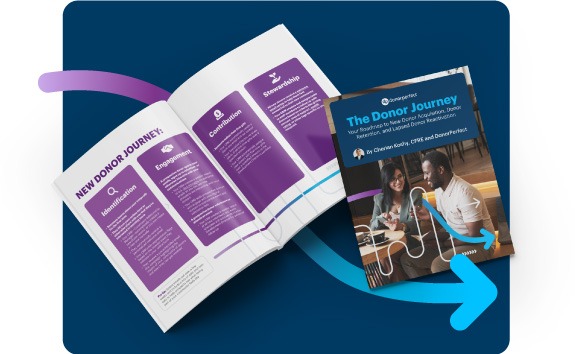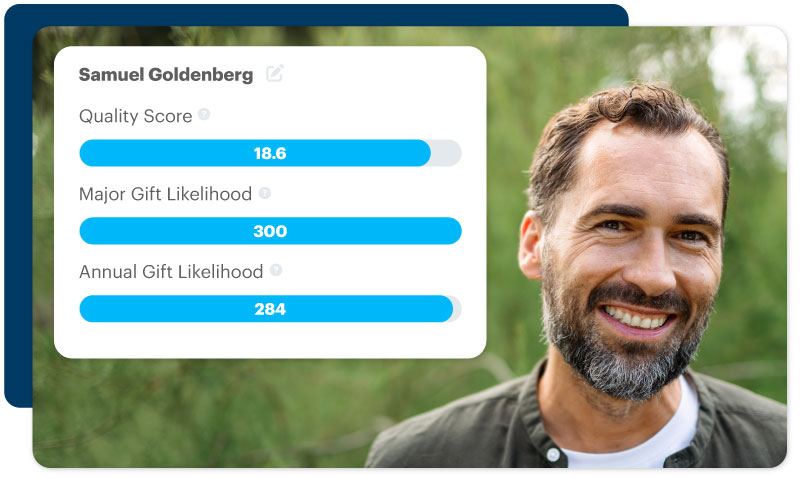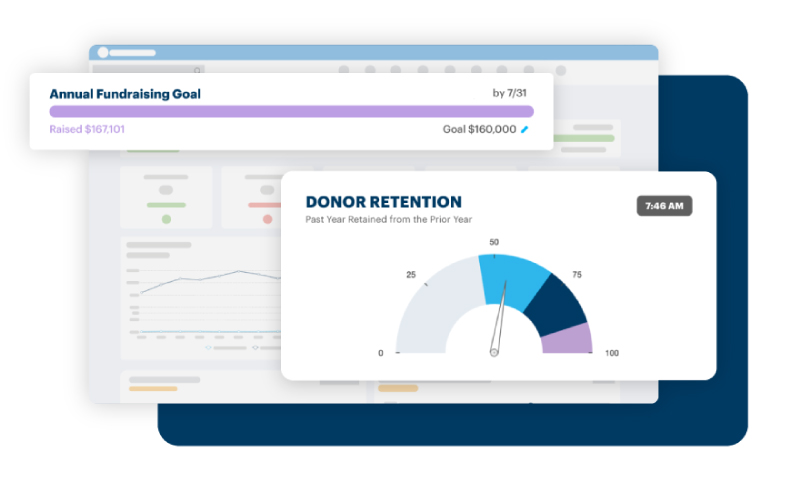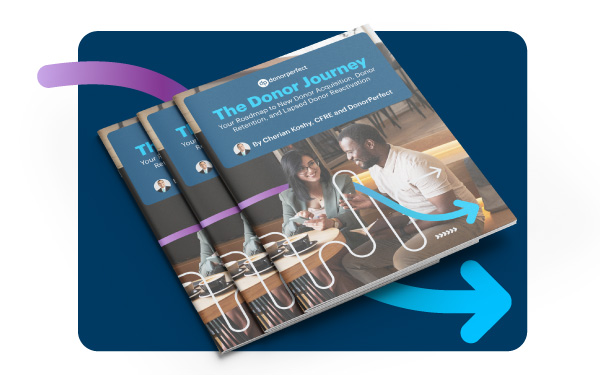Nonprofit Technology & Fundraising Blog
Subscribe to our mailing list

March 19, 2025 | Donor Engagement, Donor Journeys, Donor Retention, Major Donors
Major gifts drive nonprofit impact, fueling mission-driven programs and transformative change. These contributions provide the critical financial support needed to advance organizational goals and create lasting change. Specifically, about 14% of revenue for small and mid-sized nonprofits comes from major gift fundraising. However, the path to securing these significant contributions is fraught with challenges. Development directors, executive directors, and board members often grapple with identifying potential major donors, cultivating meaningful relationships, and navigating the complexities of solicitation.
In today’s fundraising environment, adopting a multichannel donor journey approach, including understanding how to read donor behavior, is essential. By leveraging various communication platforms—such as email, social media, direct mail, events, and personal interactions—nonprofits can create personalized experiences that resonate with major donors.
This comprehensive guide delves into fundraisers’ fears and challenges, offers strategies for effective major gift cultivation and stewardship, and illustrates how a donor journey framework can enhance major gift development.
A well-structured donor journey helps fundraisers anticipate major donor needs at every stage—from initial interest to lifelong engagement. The Donor Journey—a free e-book from fundraising expert Cherian Koshy and the DonorPerfect team—offers actionable insights for mapping and personalizing donor experiences.

A major gift is a significant philanthropic contribution that is crucial in advancing a nonprofit’s mission. While the value of a major gift varies by organization, the major gift threshold can be determined based on factors such as:
While major gifts can come from individual donors, foundations, grantor organizations, or corporate partners, this guide primarily focuses on individual major donors—those whose giving capacity and engagement history position them as key philanthropic partners. By leveraging donor data and engagement insights, fundraisers can create personalized strategies that align with donor capacity and philanthropic priorities.
Donor journeys refer to the experience a donor has with an organization, from initial awareness to ongoing engagement. Understanding this journey allows nonprofits to tailor their strategies to meet donors where they are, fostering deeper connections and sustained support. While any prospect or donor can follow their own journey, here are some examples of major donor journeys based on those who have a higher capacity to give.
Major donors don’t follow a one-size-fits-all path. Their engagement varies based on their giving history, interests, and relationship with your nonprofit. Below are three common major donor journeys that organizations should consider when developing engagement strategies.
New major donor journey
A prospect with the capacity to make a major gift learns about your organization—perhaps through an event, peer introduction, or mission-driven storytelling. Their journey involves personalized engagement, relationship-building, and a strategic ask that aligns with their philanthropic values.
Did you know? On average, nonprofits raising less than $10 million per year are cultivating at least 24 donors for a first-time major gift.
Major donor retention and upgrade journey
A committed donor has supported your organization with a major gift for years, but has yet to expand their impact. Encouraging continued engagement through meaningful recognition, shared impact stories, and aligned giving opportunities can lead to increased support or new involvement.
Lapsed major donor reactivation journey
A previously engaged major donor has not given in several years. Whether due to shifting interests, financial changes, or a lack of recent engagement, reactivating their involvement requires thoughtful re-engagement, mission updates, and opportunities that inspire renewed support.
Recognizing these donor journeys is just the beginning. To cultivate and sustain major donor relationships, nonprofits must implement a multichannel engagement strategy that nurtures donors at every stage. Next, we’ll explore common challenges fundraisers face in major gift development, followed by a deep dive into how nonprofits can apply a data-driven major donor journey approach (without fear) to enhance engagement, retention, and impact.
Discover how to create deeper, longer-lasting donor relationships using behavioral science strategies from nonprofit expert Cherian Koshy, CFRE.
Watch NowDespite the critical role of major gifts in nonprofit success, many fundraisers face hesitation and uncertainty during the process. Whether it’s identifying the right donors, making the ask, or handling rejection, these fears can create roadblocks to securing transformational gifts. The good news is that these challenges can be overcome with strategic approaches and a donor-centered mindset.
Here are some common fears, challenges, and solutions that fundraisers can face when working to secure major gifts from new and existing donors. Later, we will connect these concepts to major gift donor journeys.
Challenge: Quantifying success in major gift fundraising can be ambiguous, leading to uncertainty about the effectiveness of strategies.
Solution: Tracking and analyzing key performance indicators (KPIs) can help fundraisers assess progress, refine their approach, and ensure long-term major gift success. Consider the following strategies:
Challenge: Identifying individuals with both the capacity and willingness to make significant contributions can be daunting.
Solution: Leveraging data-driven insights and donor engagement tracking can help fundraisers identify and prioritize prospective major donors more effectively. Key strategies include:
With DonorPerfect’s DonorSearch integration, you can perform prospect research and wealth screenings to uncover major donors in your system and network.

Pro tip: Run annual reports to catch automatic or non-recurring gifts from donors to see if they reach major donor status at your nonprofit. Recurring donors could be hidden major donors!
Challenge: Asking for too much or too little could jeopardize the donor relationship and the potential gift.
Solution: Conducting thorough research and aligning the ask with a donor’s capacity and interests can increase the likelihood of a successful solicitation. Fundraisers should consider:
Pro tip: Leverage data-driven insights like capacity range based on wealth (estimated 5-year giving capacity range based upon a combination of real estate, stock information, business revenues, political giving, and pension info) to refine your solicitation strategy. Analyzing a donor’s past giving history, wealth screening indicators, and engagement trends can help determine an appropriate ask amount. Use engagement models and predictive modeling to align your request with the donor’s giving potential while ensuring it feels both aspirational and achievable.
Challenge: The emotional toll of rejection can deter fundraisers from making initial contact or making future asks if communication or visits do not have positive outcomes.
Solution: Reframing rejection as an opportunity for learning and relationship-building can help fundraisers maintain donor engagement and refine future approaches. Consider these steps:
Pro tip: Often, a donor is not able to give at the moment (not the right time) or is thinking about their budget (the right amount) so be patient and understanding while trying to secure a meeting or major gift funding.
Challenge: Even experienced fundraisers can fall into common traps that can jeopardize donor relationships and major gift opportunities. From misjudging timing to relying too heavily on a single approach, these missteps can lead to disengagement, lost gifts, or donor fatigue.
Solution: Being mindful of these pitfalls and adopting best practices can help fundraisers navigate major gift cultivation more effectively. Here’s what to watch out for:
By addressing these common fundraising fears, taking calculated risks, and embracing a thoughtful, donor-centered approach, fundraisers can create personalized donor journey roadmaps to cultivate stronger relationships and improve major gift outcomes.
With DonorPerfect, you can create simple, sophisticated reports to analyze your fundraising efforts and summarize donor information, giving history, and engagement notes.

While any donor can engage with your nonprofit, major donors have unique engagement paths that require tailored strategies. Whether they are new major donors, upgrading their gifts, or reactivating after a lapse, understanding their journey ensures fundraisers can personalize outreach, deepen relationships, and secure long-term commitment.
By leveraging CRM tools like DonorPerfect, nonprofits can automate key touchpoints along the donor journey—personalized thank-yous, engagement tracking, and tailored appeals based on giving behavior. Learn more in The Donor Journey — a free guide from Cherian Koshy, CFRE, and the experts at DonorPerfect.

Here’s how a multichannel donor journey approach applies to major donors at different engagement stages:
1. New major donor journey: Engaging a first-time major gift prospect without fear
Scenario: A prospective donor attends a university’s scholarship lunch and expresses interest in establishing a named, endowed scholarship to support undergraduate students. Aside from being a one-time event attendee, there are no other details about this prospect in your nonprofit CRM.
Multichannel engagement strategy
Immediate follow-up:
Personalized education and engagement:
Seamless transition to solicitation:
Key outcome: The donor makes a $50,000 initial commitment to name an annual scholarship fund and is welcomed into an exclusive donor recognition society, with a plan to meet student scholarship recipients.
2. Major donor upgrade journey: Moving a loyal major donor to a higher giving level while navigating some hesitation around endowments
Scenario: A donor has contributed $25,000 annually for five years to a non-endowed fund, but has not increased their giving. The donor recently attended a capital campaign event and expressed interest in expanding their support, but has hesitations about giving to an endowed fund versus an annual fund.
Multichannel engagement strategy
Reinforce their impact:
Introduce an upgrade opportunity:
Create a transformational giving proposal:
Key outcome: The donor increases their annual commitment to $50,000 to support immediate needs, and pledges an additional $250,000 to the capital campaign’s endowed fund to establish a new, named scholarship fund.
3. Lapsed major donor reactivation journey: Re-engaging a previously engaged major donor
Scenario: A donor who previously gave $100,000 annually has not made a gift in three years. They have stopped attending events and haven’t responded to recent solicitations.
Multichannel engagement strategy
Authentic acknowledgment and warm reconnection:
Exclusive re-engagement opportunities:
Thoughtful gift reintroduction:
Key outcome: After some meaningful discussion, the donor re-engages with a $25,000 renewal gift and agrees to explore a larger commitment in the next fiscal year.
To learn more about donor journeys, check out our latest blog: Donor Journeys: What They are & How to Personalize Them.
Most donors expect ongoing, personalized interactions across multiple channels. Adopting a donor journeys fundraising strategy allows nonprofits to build deeper relationships, increase donor retention, and secure transformational gifts that drive mission impact. A well-executed multichannel donor journey strategy ensures that every major donor feels heard, valued, and inspired to continue supporting your organization for years to come.
DonorPerfect’s powerful donor management tools empower nonprofits to track engagement, personalize outreach, and steward major donors with confidence. Ready to transform your fundraising strategy? Download your free Donor Journey guide today and start building stronger donor relationships.
1. What makes a multichannel donor journey different from traditional prospect management?
2. How can I determine which channels are most effective for my major donors?
3. Should I use automation in major gift fundraising, or does it need to be entirely personal?
4. What are some common mistakes in major gift fundraising, and how can a multichannel approach help?
Get your free Donor Journey guide
Follow us on social!